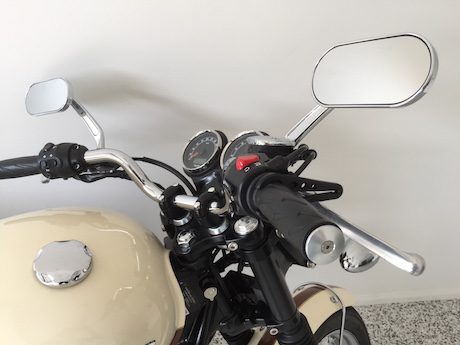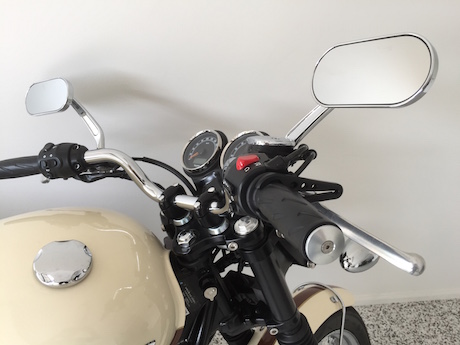Some people don’t think they need motorcycle mirrors because they are going faster than the rest of the traffic.
In fact, in some South East Asian countries where mirrors are mandatory but never used, riders wind them in, facing forwards!
That seems to work in those countries where everyone travels slowly and traffic flows like water. However, in western countries, most motorcycle accidents are rear-enders, so it’s a pretty good idea to make sure your mirrors are adjusted properly.
The actual physical adjustment of mirror arms varies with mirror types. The most common is the two nuts which lock against each other. You will need a spanner or wrench to make the adjustment.
First, set the mirrors in their middle position at the end of the arm, so you have maximum fine-tuning movement when the mirror arms are secured.
Next, loosen off the bolts with the spanner, leaving a gap between the two. If they are chromed, use a piece of paper or rag between the bolt and spanner so it doesn’t scuff the chrome.
Now, sit on your bike in the riding position to adjust the mirrors. If you have a centre stand, use that. If not, get someone to hold you, or put the bike close to a wall and hold the bike vertical with your hand.
It is now time to adjust the mirror arms.
Bikes are different from cars which have wing mirrors and a central mirror. If adjusted correctly, drivers should have complete rear coverage without any blind spots. However, motorcycle mirrors don’t have a central mirror and often have big blind spots, so always do shoulder checks.
The best position for your motorcycle mirrors will always be a compromise. You either see what’s behind you, what’s behind and to one side of your bike, or what’s on either side of you, but not what’s behind.
If you are in traffic, you should know what is behind you and what is in the right lane (or left lane in the US) as this is where passing vehicles will appear.
Therefore, my advice is to set your left mirror (right for US) to see what is behind you and set the other mirror for what is in your rear-three-quarters vision.
With your mirrors in the correct position, finger-tighten the lower bolt, then wind in the outer bolt with your fingers. If you are sure it’s right, you can tighten the outside bolt with a spanner. Don’t over-tighten.
If you don’t have a spanner, you can adjust the mirrors slightly shallower on the left and wider on the right, then just turn the mirror clockwise to the correct position which will tighten the nuts. This can take some trial and error, but it’s do-able.
Adjustment of the mirror on the end of the arm will fine-tune the position.
Always shoulder check before changing lanes or turning, but be especially aware that you will have a blind spot on the left (right in US).
If you are riding off road and frequently standing up, tilt your left (right in US) mirror upwards so you can see who’s behind you.
If your mirrors vibrate and all you can see if a blur, buy a thick rubber washer, or get specialised vibration isolators from your dealer and fit them between the mirror mount and the mirror bar.
- How do you set your mirrors? Tell us your tips in the “Leave a reply” section below.



